Anthem Stamp Freaks and Errors

In philately, "errors, freaks, and oddities" or "EFO" is a blanket term referring to all the kinds of things that can go wrong when producing postage stamps. It encompasses everything from major design errors to stamps that are just poorly printed, and includes both some of the most sought-after and expensive of all stamps, and others that attract the attention of only a few specialists.
Once the yellow-inverted error of the US 1962 Dag Hammarskjöld memorial stamp was discovered, 40,270,000 were printed to prevent speculation. An error is any sort of production mistake that is (potentially) replicated on many stamps; the famous Inverted Jenny is the best known of these, having resulted from a sheet of partial prints being accidentally re-inserted into the printing press upside down for the second color, resulting in an invert error. Design errors include wrong dates, wrong names, wrong pictures, anachronisms and the like. Only the original unintentionally printed specimens are considered to be errors.

Color errors include stamps like the Treskilling Yellow which should have been green, as well as missing colors in modern multi-colored stamp s. It is not especially rare for the perforating equipment to malfunction and result in imperforate/ perforation errors.
A freak is a one-time mishap in the production process. Freaks include paper folds resulting in half-printed half-blank stamps, "crazy perfs" running diagonally across stamps, and insects embedded in stamps, underneath the ink.
An oddity is something that is within the bounds of usability for the stamp, but still has a distinctive appearance. The usual sort of oddity is misregistration on a multi-colored stamp, which can result in shirts apparently with two sets of buttons, eyes above the top of a person's head, and so forth. These can be extremely common. The Canadian Christmas stamp of 1898, depicting a map of the world with British possessions in red, is famous for unusual color oddities that appear to claim all of Europe, or the United States, or central Asia for Britain.

Postal authorities generally take some care to ensure that mistakes don't get out of the printing plant; to be valid, the EFO stamps must have been sold to a customer. Mistakes smuggled out by unscrupulous employees are called printer's waste, not recognized as legitimate stamps, and may be confiscated from collectors; the Nixon invert is a well-known recent example of an apparent new error that turned out to be simple theft by insiders. The authorities may attempt to lay hands on legitimately-sold errors, as happened with the original Inverted Jenny sheet, but usually collectors are smart enough to hang onto the windfall.

Here are a few of the stamps errors/freaks seen in anthem stamps. First is the color error from the Bolivian anthem stamps. The color should have been green instead of blue, and features the National anthem composer and lyricist. The second is a perforation error from Vietnam. You'll notice that the perforation is through the stamp and not at the edges. It shows the musical score of Vietnam's national anthem. The third is a color error of Bangladesh and India anthem composer Rabindranath Tagore. The last is a duplication error from Galicia which shows the score of the Galician anthem.






